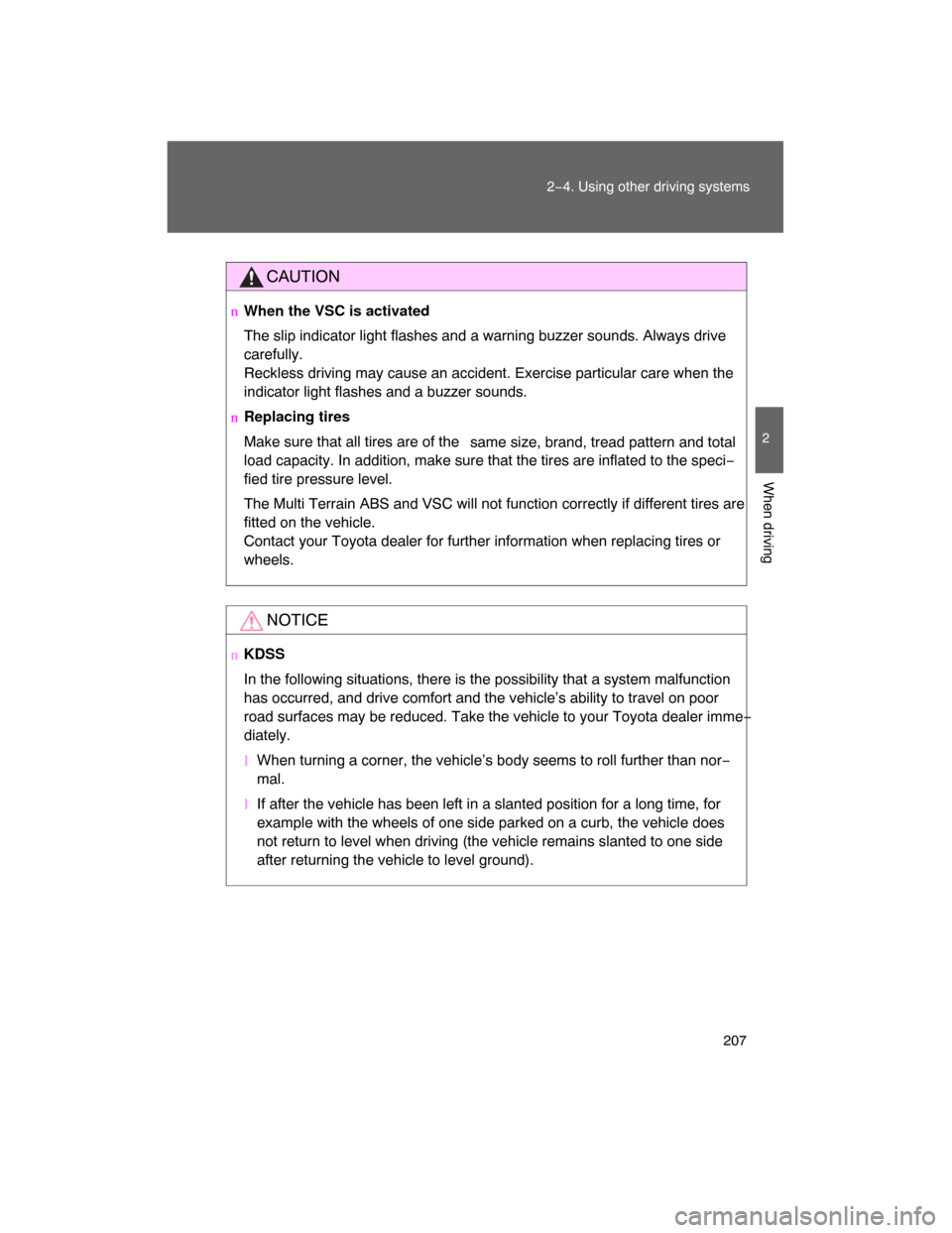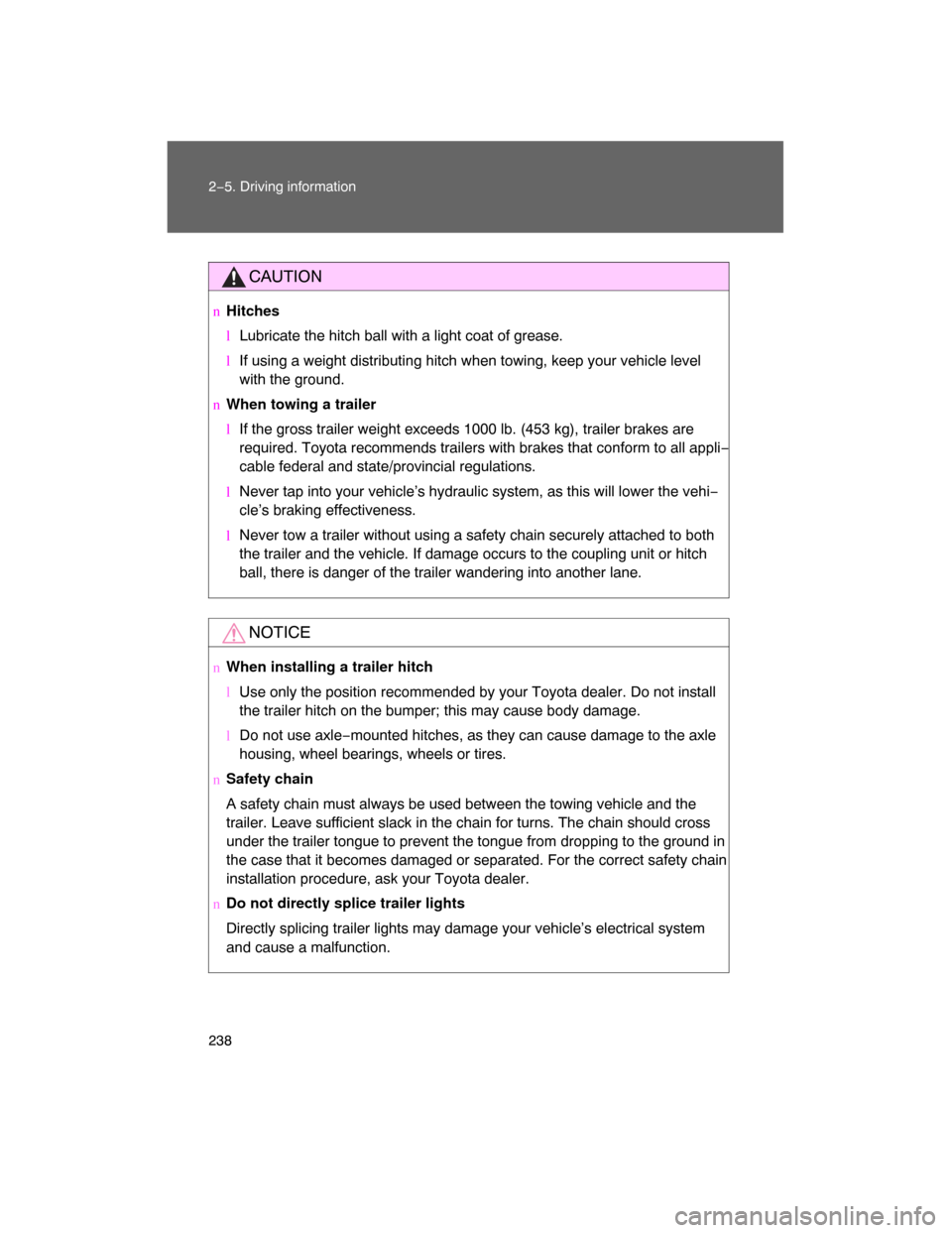Page 205 of 531

207
2−4. Using other driving systems
2
When driving
CAUTION
nWhen the VSC is activated
The slip indicator light flashes and a warning buzzer sounds. Always drive
carefully.
Reckless driving may cause an accident. Exercise particular care when the
indicator light flashes and a buzzer sounds.
nReplacing tires
Make sure that all tires are of the
same size, brand, tread pattern and total
load capacity. In addition, make sure that the tires are inflated to the speci−
fied tire pressure level.
The Multi Terrain ABS and VSC will not function correctly if different tires are
fitted on the vehicle.
Contact your Toyota dealer for further information when replacing tires or
wheels.
NOTICE
nKDSS
In the following situations, there is the possibility that a system malfunction
has occurred, and drive comfort and the vehicle’s ability to travel on poor
road surfaces may be reduced. Take the vehicle to your Toyota dealer imme−
diately.
lWhen turning a corner, the vehicle’s body seems to roll further than nor−
mal.
l
If after the vehicle has been left in a slanted position for a long time, for
example with the wheels of one side parked on a curb, the vehicle does
not return to level when driving (the vehicle remains slanted to one side
after returning the vehicle to level ground).
Page 230 of 531
232 2−5. Driving information
Selecting trailer ball
Use the correct trailer ball for your application.
Trailer ball load rating
Matches or exceeds the gross
trailer weight rating of the trailer.
Ball diameter
Matches the size of the trailer
coupler. Most couplers are
stamped with the required trailer
ball size.
Shank length
Protrudes beyond the bottom of
the lock washer and nut at least 2
threads.
Shank diameter
Matches the ball mount hole
diameter size.
Connecting trailer lights
Use the wire harness stored in
the rear end under body.
ITY25C009
Page 231 of 531

233
2−5. Driving information
2
When driving
Trailer towing tips
Your vehicle will handle differently when towing a trailer. The 3 main
causes of vehicle−trailer accidents
are driver error, excessive speed
and improper trailer loading. Keep the following in mind when towing.
l
Before starting out, check the trailer lights and the vehicle−trailer
connections. Recheck after driving a short distance.
lPractice turning, stopping and reve rsing with the trailer attached in
an area away from traffic until you become accustomed to the feel
of the vehicle.
l
Reversing with a trailer attached is difficult and requires practice.
Grip the bottom of the steering wheel and move your hand to the
left to move the trailer to the left. Move your hand to the right to
move the trailer to right. (This
is generally opposite to reversing
without a trailer attached.) Avoid sharp or prolonged turning. Have
someone guide you when reversing to reduce the risk of an acci−
dent.
lAs stopping distance is increased when towing a trailer, vehicle−to
vehicle distance should be increased. For each 10 mph (16 km/h)
of speed, allow at least o
ne vehicle and trailer length.
lAvoid sudden braking as you may skid, resulting in jackknifing and
loss of control. This is especiall
y true on wet or slippery surfaces.
lAvoid jerky starts or sudden acceleration.
l
Avoid jerky steering and sharp turns, and slow down before mak−
ing turns.
Page 234 of 531

236 2−5. Driving information
nBefore towing
Check that the following conditions are met:
lThe vehicle’s tires are properly inflated.
lTrailer tires are inflated according to the trailer manufacturer ’s recom−
mendation.
lAll trailer lights work.
lAll lights work each time you connect them.
lThe trailer ball is set up at the proper height for the coupler on the trailer.
lThe vehicle remains level when a loaded or unloaded trailer is hitched.
Do not drive if the vehicle is not level, and check for improper tongue
load, overloading, worn suspension, or other possible causes.
lThe trailer cargo is securely loaded.
lThe rear view mirrors conform to all applicable federal, state/provincial or
local regulations. If they do not, install rear view mirrors appropriate for
towing purposes.
nBreak�in schedule
Toyota recommends that you do not use a new vehicle or a vehicle with any
new power train components (engine, transmission, differential, wheel bear−
ings, etc.) to tow a trailer for the first 500 miles (800 km) of driving.
nMaintenance
lIf you tow a trailer, your vehicle will require more frequent maintenance
due to the additional load. (See “Scheduled Maintenance Guide” or
“Owner ’s Manual Supplement”.)
lRetighten the fixing bolts of the towing ball after approximately 600 miles
(1000 km) of trailer towing.
Page 236 of 531

238 2−5. Driving information
CAUTION
nHitches
lLubricate the hitch ball with a light coat of grease.
lIf using a weight distributing hitch when towing, keep your vehicle level
with the ground.
nWhen towing a trailer
lIf the gross trailer weight exceeds 1000 lb. (453 kg), trailer brakes are
required. Toyota recommends trailers with brakes that conform to all appli−
cable federal and state/provincial regulations.
lNever tap into your vehicle’s hydraulic system, as this will lower the vehi−
cle’s braking effectiveness.
lNever tow a trailer without using a safety chain securely attached to both
the trailer and the vehicle. If damage occurs to the coupling unit or hitch
ball, there is danger of the trailer wandering into another lane.
NOTICE
nWhen installing a trailer hitch
lUse only the position recommended by your Toyota dealer. Do not install
the trailer hitch on the bumper; this may cause body damage.
lDo not use axle−mounted hitches, as they can cause damage to the axle
housing, wheel bearings, wheels or tires.
nSafety chain
A safety chain must always be used between the towing vehicle and the
trailer. Leave sufficient slack in the chain for turns. The chain should cross
under the trailer tongue to prevent the tongue from dropping to the ground in
the case that it becomes damaged or separated. For the correct safety chain
installation procedure, ask your Toyota dealer.
nDo not directly splice trailer lights
Directly splicing trailer lights may damage your vehicle’s electrical system
and cause a malfunction.
Page 268 of 531
272 3−2. Using the audio system
NOTICE
nPlayer precautions
Failure to follow the precautions below may result in damage to the CDs or
the player itself.
lDo not insert anything other than CDs into the CD slot.
lDo not apply oil to the player.
lStore CDs away from direct sunlight.
l
Never try to disassemble any part of the player.
lDo not insert more than one CD at a
time.
Page 287 of 531
291
3−3. Using the rear seat entertainment system
3
Interior features
NOTICE
nCleaning the display
Wipe the display with a dry soft cloth.
If the screen is wiped with a rough cloth, the surface of the screen may be
scratched.
nTo prevent damage to the remote control
lKeep the remote control away from direct sunlight, high temperature and
high humidity.
lDo not drop or knock the remote control against hard objects.
lDo not sit on or place heavy objects on the remote control.
nDVD player
Never try to disassemble or oil any part of the DVD player. Do not insert any−
thing other than a disc into the slot.
nClosing the display
Do not close the display using your hand. Doing so may result in a malfunc−
tion.
Page 316 of 531
320 3−3. Using the rear seat entertainment system
NOTICE
n
P. 271
nPlayer precautions
Failure to follow the precautions below may result in damage to the discs or
the player itself.
lDo not insert anything other than discs into the disc slot.
lDo not apply oil to the player.
lStore discs away from direct sunlight.
l
Never try to disassemble any part of the player.